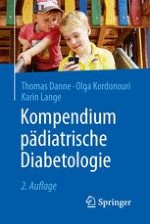2016 | OriginalPaper | Buchkapitel
11. Diabetische Ketoazidose (DKA) und hyperglykämisches hyperosmolares Syndrom
verfasst von : Prof. Dr. med. O. Kordonouri, Prof. Dr. med. T. Danne, Prof. Dr. rer. nat. K. Lange
Erschienen in: Kompendium pädiatrische Diabetologie
Verlag: Springer Berlin Heidelberg











